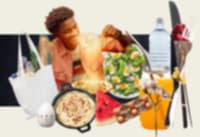

What impacts your food choices?
Let us take you on a journey through some of the food environments in which we make choices each and every day and learn about the impact of your decisions. Shop with us at the supermarket, have a bite at the restaurant and canteen, or order online to eat comfortably at home!


ONLINE DELIVERY
Feeling tired or even a little lazy today? In cities, ordering takeaway is so easy nowadays with online delivery services. But you probably don’t realise that they also have a huge influence on what you order. Explore how they shape your food choices.



Spend 30 EUR and get 20% off! How often have you fallen for these offers and ordered more? Online delivery will often push deals and certain restaurants, which might influence us to order and spend more when we don’t necessarily have to.
But is it actually healthy? Delivery services usually have this category, which pushes users to think they are making higher quality and healthy choices, but in reality, that may not always be the case.
Comfort food or lower quality food? Unhealthy food and/or lower quality items are often marketed as ‘comfort food’, which promotes unhealthy and unsustainable eating habits, especially when there is usually a large selection of comfort food available online.
Add your filtre
The default options on the browsing pages of online delivery services are typically meat-based. Meat options also often widely outnumber other more sustainable dietary options, which go through an additional filtre process. This encourages meat consumption, but also makes it easier to select unsustainable and/or unhealthy foods.
If you knew your carbon footprint, what would your option be?

112 options available.
-Highest carbon footprint-
With current meat production practices and consumption, you would be contributing to 13.7 billion tonnes of CO2(eq) per year.
112 options available.
-Highest carbon footprint-
With current meat production practices and consumption, you would be contributing to 13.7 billion tonnes of CO2(eq) per year.

21 options available.
-Mid to high carbon footprint-
By choosing a pescatarian diet, you could help the world reduce up to 4 billion tonnes of CO2(eq) per year,* but you risk buying unsustainable fish which contributes to the depletion of our ocean.
21 options available.
-Mid to high carbon footprint-
By choosing a pescatarian diet, you could help the world reduce up to 4 billion tonnes of CO2(eq) per year,* but you risk buying unsustainable fish which contributes to the depletion of our ocean.

23 options available.
-Lower carbon footprint-
By choosing a vegetarian diet, you could help the world reduce up to 6 billion tonnes of CO2(eq) per year.*
23 options available.
-Lower carbon footprint-
By choosing a vegetarian diet, you could help the world reduce up to 6 billion tonnes of CO2(eq) per year.*

13 options available.
-Lowest carbon footprint-
By choosing a vegan meal, you could help the world reduce up to 8 billion tonnes of CO2(eq) per year.*
13 options available.
-Lowest carbon footprint-
By choosing a vegan meal, you could help the world reduce up to 8 billion tonnes of CO2(eq) per year.*
For your reference: 1 tonne of CO2 is equal to 2,6 economy flights from Amsterdam to Rome
*Greenhouse gas emissions savings potential from global adoption of named diet.
What online delivery services can do
To promote more sustainable options, online delivery services can engage with more plant-based retailers and make vegetarian and vegan more visible.
What do you feel like having?
Online delivery services often promote certain foods through categories on their homepage or filtres in their navigation. This makes it easy for us to pick and choose our foods, but it also directs us to specific items.
// Choose one of the bubbles

Choose your delivery time
How long are you willing to wait for your food? Online delivery services are usually used for convenience, so slower delivery times may impact food choices.
// Choose one of the bubbles


What you can do
During your order checkout, you can make a note in the comments to exclude any unnecessary packaging to minimise your waste.What government can do
At the moment, we aren’t given a choice for the type of packaging our food is delivered in. A lot of plastic waste comes with online delivery services, but government policies and restrictions can help minimise the amount of plastic waste generated by online delivery orders. As of July 2021, the EU’s Directive on single-use plastics took effect, which includes a ban on plastic utensils, straws, packets and plastic bags.
Choose your add-ons
Do you really need these add-ons? Many online delivery services now have a surcharge for any add-ons, which can help prevent waste.
// Choose one of the bubbles

Place your order
The restaurant is preparing your order. In the meantime, take a moment to see how you can contribute to healthy and sustainable food consumption!


Cook Yourself
Before you cook, you need to pick up some ingredients from the grocery store.
Choose your ingredients for a homemade pasta dish!



Tempted by the lower price? You’re not alone. Affordable prices are often a huge factor in choosing food. Retailers’ store brand options are usually lower in price compared to name brand alternatives.
While name brands are more expensive, they can often have higher quality pasta. Of course, this will depend on the sourcing standards of each brand, but higher quality pasta can have a lower impact on biodiversity loss and lower use of chemicals.
Choose your pasta
// Choose one of the bubbles


What makes these tinned tomatoes cheap? To maintain lower prices for consumers, retailers may engage in ‘reverse auctions’, where suppliers or producers auction against one another to sell their product at the cheapest price to the retailer - whoever can supply the cheapest product, wins. This can create knock-off effects like labour exploitation at the farm level and agricultural intensification to increase the level of yield.
1.20 EUR
Have you ever bought tomatoes that are attached to the original stem?
Our perception of ‘fresh’ impacts our perception of quality, and our willingness to pay more. Similarly, many marketers will play on our perception of sustainability to sell their products with greenwashing tactics.
What you can do
Choosing organic certified tomatoes has a higher likelihood of ensuring fair and environmentally beneficial practices at the farm level.
Don’t fall for greenwashing products. Do your research to understand more about the sustainability of different products and companies.
What governments can do
The EU is currently working on a proposal to increase the sustainability of its food supply chains by providing consumers more information about the social and environmental aspects of sustainability through a sustainability label.

Choose your tomatoes
// Choose one of the bubbles


Are you sure? Beef production also contributes to serious issues like land and water degradation, biodiversity loss and methane emissions. But this information does not appear on packaging or labels.
Did you know?
You actually pay twice for meat, once in the market and once through your taxes. 18-20% of the EU’s total budget went to support livestock farming across Europe in 2019.
Did you also know?
We consume much more meat than is suggested for our health and the health of the planet.
Try vegetables sauce or pulses instead.
Meat alternatives are now increasingly available at supermarkets. Retailers have growing selections of meat alternatives placed in one section, making it more convenient for us to find what we need. However, they can still be more expensive (on average) than conventional beef.
Did you know?
Soy produced in Europe is playing an increasing role in providing a sustainable protein supply. Soy for human consumption is already grown in many parts of Europe. Because the soy plant is naturally fixing nitrogen, it reduces the need for energy-intensive artificial fertilisers.
What you can do
Try plant-based alternatives! There are other sustainable options like pulses and legumes, and even meat alternatives.
What retailers can do
Retailers can and should push more sustainable plant-based foods and alternatives through promotions and product placement.
What governments can do
The EU should redirect its subsidies to stimulate sustainable production systems. Governments can encourage their citizens to eat less meat by supporting low income households with vouchers for sustainable food products, or lowering the VAT of non-meat products like fruits and vegetables.

Choose your meat
// Choose one of the bubbles


Compared to conventional production, organic production of olive oil has many environmental benefits, including higher conservation of healthy soil properties, higher carbon storage, and improved biodiversity.
Olive oil production is mainly large-scale and highly intensive which has led to soil erosion, habitat and biodiversity loss.
Important Note
Even if farmers use organic practices, they might not be certified as the process is lengthy and requires a fee that not all farmers can afford. Organic production is also more expensive for farmers and requires a high investment in the early stages, while also producing lower yields. There are also other ways to produce food sustainably, like with agroecological practices.What governments can do
To encourage more sustainable food production practices, governments should support agroecological and organic practices.
Choose your oil
// Choose one of the bubbles


Organic might be more expensive, but it also ensures that environmentally beneficial practices are used throughout the entire food chain! Certified organic encourages producers to responsibly use energy and natural resources, maintain biodiversity, enhance soil fertility and maintain water quality.
Did you know?
Under its Farm to Fork strategy, the EU aims to use 25% of its agricultural land for organic farming by 2030.
The cheaper option, though (probably) not as sustainable! Sometimes retailers place both sustainable and unsustainable options at different price points next to one another, many people who don’t know about organic practices will choose the less sustainable option. Other retailers gather all organic products in a part of the store that is not easy to find.
What about the true cost of food?
The cost of food currently does not include environmental or social costs. If these costs are considered in the final price, organic might actually be one of the cheapest options.
Choose your garlic
// Choose one of the bubbles


If you really want cheese, be mindful of the cheese you opt for. Oftentimes, you will migrate to cheese you already know, but that might not be a sustainable option.
The classic, parmesan cheese! As consumers, we are more likely to choose products we have been most exposed to, but it might not always be produced sustainably. Marketing practices tend to promote certain types of food over others, which leads us to make our diets less diverse.
Ever heard of Aged Asiago? It’s a common cheese from the Veneto region of Italy that is used in pastas, salads and more. As consumers, we are more likely to choose products and brands we have been most exposed to.
Are you sure you need cheese? Unsustainable dairy production contributes to issues like intensive land and freshwater use, water pollution, loss of ecologically important areas (like wetlands and forests), and increased methane emissions.
What you can do
While we might gravitate towards familiar products because they are more recognised or marketed, we can make more conscious choices based on sustainability rather than popularity. Organic options, for example, will have higher animal welfare and environmental standards.

Choose your cheese
// Choose one of the bubbles


As you approach the checkout, you come across a big fridge filled with bottles of water. Suddenly you feel thirsty and you are tempted to get one! But did you know that the life cycle of bottled water uses fossil fuels, contributes to global warming, and causes pollution?
Who needs a fizzy drink when you have water at home?
Retailers will often promote products through offers like buy one, get one free. This pushes us to buy more food and drinks we don’t need, as it supports the idea that we’re saving money.
Think this is a healthier option? Just because it says ‘Zero Calorie’? Labels like Zero Calorie might seem like it’s ‘healthier’, but it’s important to look at the label for its other nutritional qualities.
What governments can do
Accurate and standardised nutritional information can promote or deter us from choosing certain foods. Policies around labelling must be strictly enforced to ensure consumers are not misled by marketing tactics.

Choose your drink
// Choose one of the bubbles


Retailers often add unhealthy items near check-out. It’s a convenient temptation, and it pushes us to buy more food we don’t need at the last minute. It also promotes unhealthy eating.
Did you know?
Most of the world’s chocolate is manufactured and consumed in Europe and North America, far from the fields in West Africa where the majority of cocoa (~75%) is grown. Cocoa production is entangled with complex economic, social, and environmental problems, including poverty, child labour, unsustainable farming practices and deforestation.
What you can do
Stick to your shopping list! Be aware that cocoa is still mainly grown in monocultures and responsible for deforestation: chocolate, like everything else, should be consumed in moderation. Get to know where your cocoa comes from and look for certified products. Even if the certification standards are not perfect, some key environmental and social criteria are taken into consideration.
What governments can do
Policies that restrict retailers from placing unhealthy options near check-out can help limit our exposure to and consumption of unhealthy foods. Governments must also invest in polyculture, innovations that minimise environmental impacts while improving yield, and infrastructures that reinforce fair payment to prevent illegal deforestation and labour exploitation.

Last minute check-out
// Choose one of the bubbles


Do you have your own reusable bag or backpack? Amazing!
For an additional 0.10 EUR!
Many countries have restrictions on single use plastic, which often means adding a surcharge like 0.10 EUR for each bag. This might seem small, but it has a huge impact on our packaging choices. It can promote habits like bringing our own reusable bags.
What you can do
Bring your own reusable bag as much as you can! But also remember, the food you decide to put in your bag has a big influence on ecological impacts and our planet. By choosing more plant-based and sustainable foods, you can help reduce your footprint and use your purchasing power to improve our food system.

Do you need a bag?
// Choose one of the bubbles

Get the bill
While the cashier is scanning the barcode of your products, take a moment to see how you can contribute to healthy and sustainable food consumption!


CANTEEN
There’s always so many options to choose from at canteens! What options will you pick today?



Different meats have different ecological footprints, but generally meat production has high impacts on greenhouse gas emissions, land and water use, and is a big contributor to water pollution.
Tip
To lower your ecological footprint, try something plant-based instead!
Plant-based protein sources have a lower environmental footprint compared to meat protein. Eating less and better meat is a more sustainable choice.
Pay close attention to the type of seafood you eat. Over 85% of our fish stocks are fully exploited or overfished, ocean habitats have been destroyed by industrial fishing gear, and there are still illegal and unregulated catches. Choosing the right fish matters.
What you can do
Do you feel like there aren’t enough sustainable, plant-based options at your canteen? Contact the canteen staff to petition for more sustainable (and affordable) options!
What canteens can do
To be more sustainable, canteens can include more plant-based and vegetarian options and protein alternatives. They also need to include fewer meat dishes while also offering sustainable meat only.
What governments can do
In the EU, there are voluntary guidelines for greener public procurement. EU institutions are currently discussing whether to include mandatory sustainability criteria specifically for food public procurement.

What do you feel like having?
How do public canteens supply so much food? Typically there is a procurement process, which requires the canteen to pick the supplier who provides the cheapest option. The problem is, this rarely takes into account environmental or social costs associated with the food.
// Choose one of the bubbles


Would your choice change if…
At the moment, nutritional information is not provided in canteens. What if canteens placed nutritional profiles next to the available options? Would that impact your food choice?
Choose again, but this time informed!

Brown Rice
White rice may be filling, but other whole-grain varieties like brown rice have higher nutritional profiles, including fibre, protein content, and manganese.
Cooked Brown Rice vs Cooked White Rice
(100g)
| Cooked Brown Rice | Cooked White Rice | |
|---|---|---|
| Energy | 112 | 130 |
| Carbs | 23.5g | 28.2g |
| Fibre | 1.8g | 0.4g |
| Fat | 0.8g | 0.3g |
| Protein | 2.3g | 2.7g |
| Iron | 0.5mg | 1.2mg |
| Magnesium | 44mg | 12mg |
| Phosphorus | 77mg | 43mg |
| Zinc | 0.6mg | 0.5mg |
| Copper | 0.1mg | 0.1mg |

Baked Potatoes
French fries are a staple in many canteens. There’s always a demand and it’s easy to produce. However, compared to other options it has a lower nutritional value and higher in calories and saturated fat.
French Fries vs Baked Potatoes
(100g)
| French Fries | Baked Potatoes | |
|---|---|---|
| Energy | 312 | 93 |
| Carbs | 41.4g | 21.2g |
| Fibre | 3.8g | 2.2g |
| Fat | 14.7g | 0.13g |
| Protein | 3.4g | 2.5g |

Steamed/Roasted Vegetables
Steamed or roasted vegetables have a high nutritional value, packed with vitamins and minerals that are necessary for a balanced and healthy diet. For example, broccoli is rich in fibre, vitamin C, calcium, potassium, folate, iron, zinc, and more.
Cooked Broccoli
(78g)
| Energy | 27.3 |
| Carbs | 5.6g |
| Fibre | 2.6g |
| Fat | 0.32g |
| Protein | 1.86g |
| Vitamin C | 50.6 mg |
| Folate | 84.2 µg |
| Calcium | 31.2mg |
| Iron | 0.5mg |
| Magnesium | 16.4mg |
| Phosphorus | 52.3mg |
| Potassium | 229mg |
| Manganese | 0.2mg |
What canteens can do
Provide more nutritional and environmental impact information to help promote healthier and more sustainable options. Canteens should make whole grain rice and pasta, steamed and roasted vegetables more affordable compared to less healthy options.

Choose your side dish
What will you have with your main dish?
// Choose one of the bubbles


This looks like the healthier option, doesn’t it? Fruit mix is often perceived to be a healthier and higher quality food, but in reality, the mix may be filled with added sugars and may not actually be so fresh anymore.
Cakes are a standard across canteens. While they are high in calories and sugars, their price may be comparable to fruit mixes or even be cheaper. The affordability factor also has an impact on our food choices.
Take an apple or orange instead
What government can do
Some EU countries already have implemented sugar taxes to help prevent non-communicable diseases, like heart disease and diabetes. The EU can also work with its member states to promote the consumption of fruit and vegetables by funding school schemes. To make healthier and more sustainable foods accessible to everyone, member states can also reduce VAT rates for such products and distribute vouchers for low-income families.

Choose your dessert
How often do you skip past the dessert section? While we don’t really need any dessert, it is a common section across most canteens. The availability and accessibility of (unhealthy) dessert options often pushes consumers towards unhealthy dietary choices.
// Choose one of the bubbles


Sorry, this option is not available. Policy restrictions on unhealthy drink options in (university) canteens can help limit consumption of unhealthy products like soda.
Not feeling something sugary or caffeinated? There’s always tap water! Canteens can do more by promoting free tap water, as it is both an affordable and healthier option.
Current procurement methods do not take into consideration the social cost of production. Ultimately, coffee and tea in canteens may come from supply chains that do not pay fair wages to farmers or harvesters, and also lead to more deforestation.
What you can do
Opt for tap water and look for coffee or tea with certification labels. Even if certification standards are not perfect, some key environmental and social criteria are taken into consideration. They can help you choose products that are more traceable, sustainable and fair when there are no policies in place that reinforce these factors.
What canteens can do
Canteens should only supply traceable and/or certified coffee or tea products. To help your canteens transition to more sustainable options, discuss this issue with other students or canteen customers, contact the canteen staff and petition for more sustainable and affordable options! Ask for transparency and information on the available foods provided by your canteen.
What government can do
The EU Commission has adopted a regulation which only allows deforestation-free products to enter the EU market. This is estimated to help reduce at least 31 million metric tons of carbon emissions annually. Now EU governments must implement and enforce this new law at national level.

Choose your drink
Do you usually take a drink with your food?
// Choose one of the bubbles

Checkout
While you are lining up to pay, take a moment to see how you can contribute to healthy and sustainable food consumption!


RESTAURANT
You’re heading over to your favourite restaurant to meet your friends and family. Start by choosing your preferred mode of transport to get there!


What you can do
While distance may have an impact on our food choices, choosing to eat at restaurants or retailers with more sustainable options can lower your environmental footprint while supporting conscious businesses.

How will you get there?
When was the last time you said a phrase like, “That place is so far” or “I’m hungry, it’ll take too long to get there”? The accessibility and location of a restaurant has a big role in our food choices.
// Choose one of the bubbles


More casual restaurants will often have a more open atmosphere for take away, particularly because portion sizes will be larger compared to fine dining.
Fine dining restaurants may have a norm to leave leftovers. But here’s a tip: bring your own box to take home any leftovers you can’t bear to leave behind.
What you can do
As consumers, we can prevent food waste by not ordering more than we really need.
What restaurants can do
Restaurants should not serve you disproportionate portions. They should also encourage a culture of packing leftovers to-go to prevent food waste, which is one of the leading causes of methane emissions globally.
What government can do
The EU is working on establishing mandatory targets to reduce food waste under their Waste Framework Directive.

Choose what to do with your leftovers
Restaurant norms will impact what you do with your leftovers. Do waiters typically ask if you would like to pack up the leftovers? Or do waiters instantly take away the leftovers when you seem to be done with the meal?
// Choose one of the bubbles

Ask for the bill
In the meantime, take a moment to see how you can contribute to healthy and sustainable food consumption!




Change starts with your plate
As you can see, what we eat has enormous implications for our health and also for the planet. Our food production is responsible for around 34% of all greenhouse gas emissions. It continues to be the main cause of deforestation and habitat loss today, affecting biodiversity and destabilising natural systems. A third of all land and 70% of global freshwater withdrawals are already used for crops and livestock - yet, agriculture is also a major source of land and water pollution.
But food production isn’t the only concern: around one-third of all food produced globally is wasted. Much of it ends up in landfills and rots, where it produces methane - a greenhouse gas 25 times as potent as carbon dioxide.
In addition to all its environmental and social impacts, our food systems are responsible for the unhealthy diets behind the deaths of 1 in 5 Europeans.
So what can you do?
How can we as individuals make changes that will help lower our impact and prevent climate and biodiversity catastrophe? Here are 6 things you can do to help make our food system more sustainable:

Choose more plant-based options
Plant-based products have a lower environmental footprint compared to animal-based products. Opt for eating less (and better) meat and fish whenever and wherever possible.

Choose food products that are sustainably produced
Use your purchasing power to support sustainable production (like organic, agroecological or regenerative practices). You can directly buy from producers or suppliers that are investing in sustainable production methods.
While it’s not always possible to always find this information in a supermarket, look out for certification labels like organic, which take into consideration some environmental and social criteria. While certification standards are not perfect, they are one step closer to standardising sustainable food production.

Minimise your food waste
Another step is to prevent food waste. Try to only buy what you need and finish your leftovers.

Speak to representatives
Talk to representatives from your schools, canteens, restaurants or local retailers about their supply chains. Mobilise with other individuals who are passionate about systematic change, and petition for more sustainable options and transparent information on food products.

Vote and support sustainable policies
Ask your local, regional and national leaders to pass legislation that supports and reinforces sustainable food systems. Demand more policies that would make sustainable food products more accessible and affordable for people of all economic backgrounds.

Educate yourself on the impact of food
It’s important to be aware of how your food environments affect your choices. It’s natural to want to buy food products based on factors like price and familiarity, but remember your power as a consumer to help drive systematic change: use your purchasing power on sustainable food products and activism to demand a better system.
Distinguishing which foods are more sustainable can be difficult, but you can start with simple swaps. See the Eat4Change Guide on sustainable swaps.
You don’t have to follow a specific diet. You don’t have to spend a lot of money. You can still enjoy your favourite foods and find some new favourites. It’s possible to cook and eat healthy, delicious food that’s good for you and good for the planet - just by making a few small changes.

What policies do we need?
As you have seen throughout this journey, the way we produce and consume food is not only unsustainable, but also detrimental to our health. Our food environments have a huge role in shaping our food choices, so we need to bring systematic change. We have been waiting to change this for many years, but our governments have lacked the political will to introduce laws to address the problem.
Support the EU Sustainable Food Systems Law
Luckily, the EU is working on a proposal for a Sustainable Food System Law that is geared to integrate sustainability into all food-related policies, including production, marketing and consumption. This is a unique opportunity to make our food environments more sustainable and encourage better food choices and healthier consumption patterns.
In the summer of 2022, WWF commissioned a survey on food habits in 12 EU countries to assess citizens’ perceptions on food and on the actions that their political representatives could undertake to make food systems more sustainable. The results show that 3 in 4 European consumers believe that EU governments should lower the prices of environmentally friendly and healthy food and help citizens to make more sustainable food choices.
This is our chance to fix the EU’s broken food systems! For the new law to be truly effective and bring about lasting change, it needs to:
- Set targets for 2050 to provide a clear direction for the transition to more sustainable food.
- Help shift consumption towards less animal-based products and more healthy and sustainable diets. This must be done not only by providing more information to consumers via a new labelling scheme, but also by establishing policy measures, tackling deceiving advertising and promotion practices, and providing dietary guidelines.
- Include mandatory criteria for food public procurement in order to support the sourcing of socially and environmentally sustainable food.
- Lower prices for sustainable food by adopting policy measures that are based on the true cost of food, which should take into account environmental and social impacts, while preventing unfair competition.
- Require Member States to develop National Food Plans which should include measurable targets for food sustainability at the national level.

Resources
Plant-based
Meat & Dairy
Seafood
Food Production Impacts
- Read more on the impact of EU’s food production and consumption on the planet
- Read more on the impact of agriculture
- Read more on the impacts of deforestation
- Read the environmental impact of sugar
- Read more about the sustainability of olive oil production
- Read more about the social cost of tinned tomatoes
Sustainable Agriculture Practices
Food Environments
Public Procurement
True Cost of Food
Food deserts
I am still hungry. I want to explore more!















